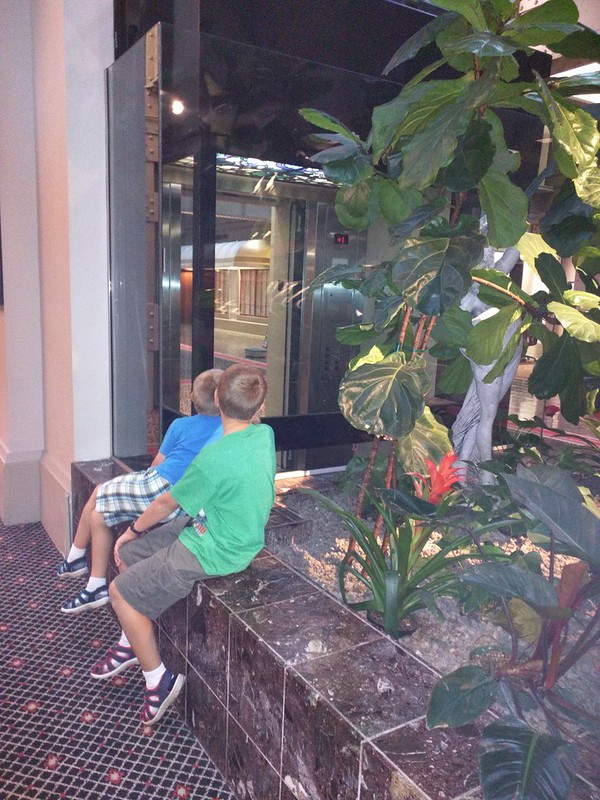Laura Arjona Reina: Underestimating Debian
 I had two issues in the last days that lead me a bit into panic until they got solved. In both cases the issue was external to Debian but I first thought that the problem was in Debian. I m not sure why I had those thoughts, I should be more confident in myself, this awesome operating system, and the community around it! The good thing is that I ll be more confident from now on, and I ve learned that hurry is not a good friend, and I should face my computer problems (and everything in life, probably) with a bit more patience (and backups).
Issue 1: Corrupt ext partition in a laptop
I have a laptop at home with dual boot Windows 7 + Debian 9 (Stretch). I rarely boot the Windows partition. When I do, I do whatever I need to do/test there, then install updates, and then shutdown the laptop or reboot in Debian to feel happy again when using computers.
Some months ago I noticed that booting in Debian was not possible and I was left in an initramfs console that was suggesting to e2fsck /dev/sda6 (my Debian partition). Then I ran e2fsck, say a to fix all the issues found, and the system was booting properly. This issue was a bit scary-looking because of the e2fsck output making screen show random numbers and scrolling quickly for 1 or 2 minutes, until all the inodes or blocks or whatever were fixed.
I thought about the disk being faulty, and ran badblocks, but faced the former boot issue again some time after, and then decided to change the disk (then I took the opportunity to make backups, and install a fresh Debian 9 Stretch in the laptop, instead of the Debian 8 stable that was running).
The experience with Stretch has been great since then, but some days ago I faced the boot issue again. Then I realised that maybe the issue was appearing when I booted Debian right after using Windows (and this was why it was appearing not very often in my timeline
I had two issues in the last days that lead me a bit into panic until they got solved. In both cases the issue was external to Debian but I first thought that the problem was in Debian. I m not sure why I had those thoughts, I should be more confident in myself, this awesome operating system, and the community around it! The good thing is that I ll be more confident from now on, and I ve learned that hurry is not a good friend, and I should face my computer problems (and everything in life, probably) with a bit more patience (and backups).
Issue 1: Corrupt ext partition in a laptop
I have a laptop at home with dual boot Windows 7 + Debian 9 (Stretch). I rarely boot the Windows partition. When I do, I do whatever I need to do/test there, then install updates, and then shutdown the laptop or reboot in Debian to feel happy again when using computers.
Some months ago I noticed that booting in Debian was not possible and I was left in an initramfs console that was suggesting to e2fsck /dev/sda6 (my Debian partition). Then I ran e2fsck, say a to fix all the issues found, and the system was booting properly. This issue was a bit scary-looking because of the e2fsck output making screen show random numbers and scrolling quickly for 1 or 2 minutes, until all the inodes or blocks or whatever were fixed.
I thought about the disk being faulty, and ran badblocks, but faced the former boot issue again some time after, and then decided to change the disk (then I took the opportunity to make backups, and install a fresh Debian 9 Stretch in the laptop, instead of the Debian 8 stable that was running).
The experience with Stretch has been great since then, but some days ago I faced the boot issue again. Then I realised that maybe the issue was appearing when I booted Debian right after using Windows (and this was why it was appearing not very often in my timeline  ). Then I payed more attention to the message that I was receiving in the console
). Then I payed more attention to the message that I was receiving in the console
Superblock checksum does not match superblock while trying to open /dev/sda6 /dev/sda6: The superblock could not be read or does not describe a valid ext2/ext3/ext4 filesystem. If the device is valid and it really contains an ext2/ext3/ext4 filesystem (and not swap or ufs or something else), then the superblock is corrupt, and you might try running e2fsck with an alternate superblock: e2fsck -b 8193 or e2fsck -b 32768and searched about it, and also asked about it to my friends in the redeslibres XMPP chat room
 I found this question in the AskUbuntu forum that was exactly my issue (I had ext2fsd installed in Windows). My friends in the XMPP room friendly yelled booo! at me for letting Windows touch my ext partitions (I apologised, it will never happen again!). I now consistently could reproduce the issue (boot Windows, then boot Debian, bang!: initramfs console, e2fsck, reboot Debian, no problem, boot Windows, boot Debian, again the problem, etc). I uninstalled the ext2fsd program and tried to reproduce the issue, and I couldn t reproduce it. So happy end.
Issue 2: Accessing Android internal memory to backup files
The other issue was with my tablet running Android 4.0.4. It was facing a charge issue, and I wanted to backup the files there before sending it to repair. I connected the tablet with USB to my laptop, and enabled USB debugging. The laptop recognized a MZ604 camera connected, but Dolphin (the file browser of my KDE Plasma desktop) could not show the files.
I looked at the settings in the tablet to try to find the setting that allowed me to switch between camera/MTP when connecting with USB, but couldn t find it. I guessed that the tablet was correctly configured because I recall having made a backup some months ago, with no hassle (in Debian 8). I checked that my Debian (9) had installed the needed packages:
I found this question in the AskUbuntu forum that was exactly my issue (I had ext2fsd installed in Windows). My friends in the XMPP room friendly yelled booo! at me for letting Windows touch my ext partitions (I apologised, it will never happen again!). I now consistently could reproduce the issue (boot Windows, then boot Debian, bang!: initramfs console, e2fsck, reboot Debian, no problem, boot Windows, boot Debian, again the problem, etc). I uninstalled the ext2fsd program and tried to reproduce the issue, and I couldn t reproduce it. So happy end.
Issue 2: Accessing Android internal memory to backup files
The other issue was with my tablet running Android 4.0.4. It was facing a charge issue, and I wanted to backup the files there before sending it to repair. I connected the tablet with USB to my laptop, and enabled USB debugging. The laptop recognized a MZ604 camera connected, but Dolphin (the file browser of my KDE Plasma desktop) could not show the files.
I looked at the settings in the tablet to try to find the setting that allowed me to switch between camera/MTP when connecting with USB, but couldn t find it. I guessed that the tablet was correctly configured because I recall having made a backup some months ago, with no hassle (in Debian 8). I checked that my Debian (9) had installed the needed packages:
ii kio-mtp 0.75+git20140304-2 amd64 access to MTP devices for applications using the KDE Platform ii libmtp-common 1.1.12-1 all Media Transfer Protocol (MTP) common files ii libmtp-runtime 1.1.12-1+b1 amd64 Media Transfer Protocol (MTP) runtime tools ii libmtp9:amd64 1.1.12-1+b1 amd64 Media Transfer Protocol (MTP) librarySo I had no idea about what was going on. Then I suspected some problem in my Debian (maybe I was needing some driver for the Motorola tablet?) and booted Windows 7 to see what happened there. Windows detected a MZ604 device too, but couldn t access the files either (when clicking in the device, no folders were shown). I began to search the internet to see if there were some Motorola drivers out there, and then found the clue to enable the correct settings in the Android device: you need to go to Settings > Storage, and then press the 3-dots button that makes the Menu function, and then appears USB computer connection and there, you can enable Camera or MTP. Very hidden setting! I enabled MTP, and then I could see the folders and files in my Windows system (without need of installing any additional driver), and make my backup. And of course after rebooting and trying in Debian, it worked too. Some outcomes/conclusions
- I have a spare hard disk for backups, tests, whatever.
- I should make backups more often (and organize my files too). Then I wouldn t be so nervous when facing connection or harddrive issues.
- I won t let my Windows touch my Debian partitions. I don t say ext2fsd is bad, but I installed it just in case and in practice I never felt the need to use it. So no need to risk (again) a corrupt ext partition.
- Having a Windows system at hand is useful some times to demonstrate myself (and maybe others) that the problems aren t usually related to Debian or other GNU/Linux.
- Having some more patient is useful too to demonstrate myself (and maybe others) that the problems aren t usually related to Debian or other GNU/Linux.
- Maybe I should put aside some money in my budget for collateral damages of my computer tinkering, or renew hardware at some time (before it definitely breaks, and not after). For example if I had renewed this tablet (it s a good one, but from 2011, Android 4, and the screen is broken, and it was not charging since one year, we were using it only plugged to AC), then my family wouldn t care if I break the old tablet trying to unlock its bootloader or install Debian on it or whatever. The same for my husband s laptop (the one with the dual boot), it s an old machine already, but it s his only computer. I already felt risky installing Debian testing on it! (I installed it in end-january, right before the full-freeze).
- OTOH, even thinking about renewing hardware made me headache. My family show advertisements from the shopping mall and I don t know if I can install Debian without nonfree blobs, or Replicant or LineageOS on those devices. I don t know the max volume that the ringtone reaches, and the max volume of the laptop speakers, or the lower possible brightness of the screens. I m picky about laptop keyboards. I don t like to spend much money in hardware that can be destroyed easily because it falls down from my hand to the floor, or I accidentally throw coffee on it. So I end enlarging the life of my current hardware, even if I don t like it much, either
Filed under: My experiences and opinion Tagged: Android, Debian, English, KDE, Libre software for Windows


 For people who are visually differently-abled, the above reads
To learn who rules over you, simply find out who you are not allowed to criticize Voltaire wrote this either in late 16th century or early 17th century and those words were as apt in those times, as it is in these turbulent times as well.
Update 05/03 According to @bla these words are attributable to a neo-nazi and apparently a child abuser. While I don t know the context in which it was shared, it describes the environment in which we are perfectly. Please see his comment for a link and better understanding.
The below topic requires a bit of maturity, so if you are easily offended, feel free not to read further.
While this week-end I was supposed to share about the recent Science Day celebrations that we did last week
For people who are visually differently-abled, the above reads
To learn who rules over you, simply find out who you are not allowed to criticize Voltaire wrote this either in late 16th century or early 17th century and those words were as apt in those times, as it is in these turbulent times as well.
Update 05/03 According to @bla these words are attributable to a neo-nazi and apparently a child abuser. While I don t know the context in which it was shared, it describes the environment in which we are perfectly. Please see his comment for a link and better understanding.
The below topic requires a bit of maturity, so if you are easily offended, feel free not to read further.
While this week-end I was supposed to share about the recent Science Day celebrations that we did last week
 Would explore it probably next week.
This week the attempt is to share thoughts which had been simmering at the back of my mind for more than 2 weeks or more and whose answers are not clear to me.
My buttons were pressed when Martin f. Kraft
Would explore it probably next week.
This week the attempt is to share thoughts which had been simmering at the back of my mind for more than 2 weeks or more and whose answers are not clear to me.
My buttons were pressed when Martin f. Kraft  From the little sharings and interactions I have been part of, I find people take offence at the most innocuous things. For instance, one of the easy routes of not offending anyone is to use self-deprecating humour (or so I thought) either of my race, caste, class or even my issues with weight and each of the above would offend somebody. Charlie Chaplin didn t have those problems. If somebody is from my caste, I m portraying the caste in a certain light, a certain slant. If I m talking about weight issues, then anybody who is like me (fat) feels that the world is laughing at them rather than at me or they will be discriminated against. While I find the last point a bit valid, it leaves with me no tools and no humour. I neither have the observational powers or the skills that
From the little sharings and interactions I have been part of, I find people take offence at the most innocuous things. For instance, one of the easy routes of not offending anyone is to use self-deprecating humour (or so I thought) either of my race, caste, class or even my issues with weight and each of the above would offend somebody. Charlie Chaplin didn t have those problems. If somebody is from my caste, I m portraying the caste in a certain light, a certain slant. If I m talking about weight issues, then anybody who is like me (fat) feels that the world is laughing at them rather than at me or they will be discriminated against. While I find the last point a bit valid, it leaves with me no tools and no humour. I neither have the observational powers or the skills that  Very strange. Verrrry strange.
Yesterday I wrote a
Very strange. Verrrry strange.
Yesterday I wrote a  debian is in deep freeze for the upcoming stretch release. still, I haven't
dived into fixing "general" release-critical bugs yet; so far I mostly kept to
working on bugs in the debian perl group:
debian is in deep freeze for the upcoming stretch release. still, I haven't
dived into fixing "general" release-critical bugs yet; so far I mostly kept to
working on bugs in the debian perl group:


 Debian LTS
November marked the 20th month I contributed to
Debian LTS
November marked the 20th month I contributed to  I am a incorrigibly in picking non-mainstream, open smartphones, and then struggling hard. Back then in 2008, I tried to
I am a incorrigibly in picking non-mainstream, open smartphones, and then struggling hard. Back then in 2008, I tried to  Before proceeding, here is some context: When building new things, it is usually better to use the
Before proceeding, here is some context: When building new things, it is usually better to use the 


 Once a month I am involved in running an informal session, loosely affiliated
with
Once a month I am involved in running an informal session, loosely affiliated
with  Have you ever thought about using a gpg key to encrypt something, but
didn't due to worries that you'd eventually lose the secret key? Or maybe
you did use a gpg key to encrypt something and lost the key. There are
nice tools like
Have you ever thought about using a gpg key to encrypt something, but
didn't due to worries that you'd eventually lose the secret key? Or maybe
you did use a gpg key to encrypt something and lost the key. There are
nice tools like 





